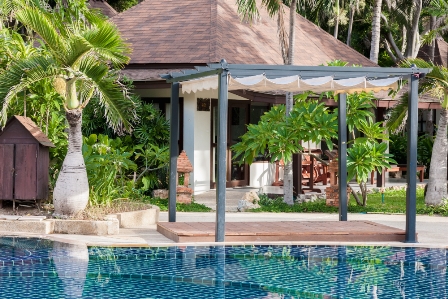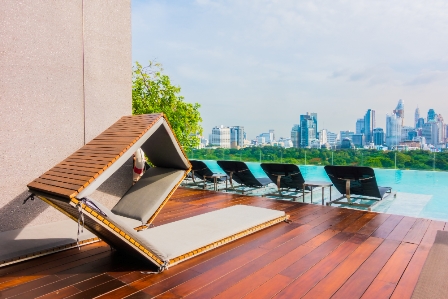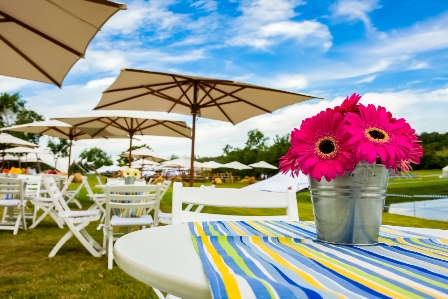Pergolas are a fantastic addition to any outdoor space, providing shade, shelter, and an aesthetically pleasing structure for relaxation and entertainment. But what if you could take your pergola to the next level? Enter waterproof pergola roofs, an ingenious solution to enhance your outdoor experience. In this article, we’ll explore the world of waterproof pergola roof ideas, from their benefits to materials, installation, and more.
1. Pros and Cons of a Waterproof Pergola Roof
Here are the pros and cons of a waterproof pergola roof:
Pros of a Waterproof Pergola Roof
- Protection from the Elements:
A waterproof pergola roof provides effective protection from rain, allowing you to use your outdoor space even during wet weather. It also shields you from the sun’s harsh rays, providing shade and comfort.
- Extended Outdoor Use:
With a waterproof roof, you can enjoy your outdoor area throughout the year, regardless of the weather. This extends your living space and increases the functionality of your pergola.
- Enhanced Aesthetics:
In choosing a pergola that complements your home’s design and your personal taste, the waterproof variant is a perfect selection as it comes with various styles, colors, and materials. They can enhance the overall aesthetics of your outdoor space.
- Customization Options:
Many waterproof roof types offer customization options, such as retractable canopies, lighting fixtures, and additional features like screens and speakers, allowing you to personalize your pergola.
- Low Maintenance:
Depending on the material chosen, waterproof pergola roofs can be low maintenance. Some materials, like aluminum and PVC, require minimal care to stay in good condition.
- Energy Savings:
By providing shade, waterproof roofs can help reduce the heat entering your home, leading to potential energy savings on cooling costs during hot months.
Cons of a Waterproof Pergola Roof
- Initial Cost:
Waterproof pergola roofs can have a higher upfront cost compared to traditional pergola setups. The cost varies based on the material and style you choose.
- Installation Complexity:
The installation of waterproof roofs can be more complex than traditional pergolas. Some may require professional installation to ensure proper setup, which can add to the overall cost.
- Limited Natural Light:
Some waterproof roofing materials, like polycarbonate panels, may limit the amount of natural light that filters through. This can impact the ambiance of your outdoor space.
- Maintenance Required:
While some materials are low maintenance, others, like wooden roofs, may require regular maintenance and sealing to prevent water damage and rot.
- Aesthetic Preferences:
The aesthetics of a waterproof pergola roof may not appeal to everyone. Some may prefer the natural look of open pergolas, and the appearance of the roof may not match their preferences.
- Environmental Impact:
Some roofing materials, especially plastic options, may have a higher environmental impact compared to traditional materials like wood. Considering eco-friendly alternatives is essential for environmentally conscious individuals.
2. Types of Waterproof Pergola Roofs

Retractable Canopy
Retractable canopies offer flexibility. You can open them up to enjoy the sunshine or close them to stay dry during rain. They are often made from durable fabric, which is easy to maintain.
Polycarbonate Panels
Polycarbonate panels are a modern choice, offering excellent protection from both rain and harmful UV rays. They are translucent, allowing natural light to filter through while keeping you dry.
Fabric Shade Sail
Shade sails are a cost-effective solution that adds a touch of style to your pergola. They come in various shapes and sizes, providing both shade and shelter.
3. Materials for a Waterproof Pergola Roof

Aluminum
Aluminum roofs are lightweight, durable, and resistant to rust. They require minimal maintenance and can be powder-coated to match your pergola’s color scheme.
Wood
Wooden roofs add a rustic charm to your outdoor space. However, they need more maintenance and are not as waterproof as other materials without proper sealing.
PVC
PVC roofs are affordable and low-maintenance. They offer good protection against the elements and come in various colors and styles.
4. Installation Process
Assessing the Pergola
Before installing a waterproof roof, assess your pergola’s structure. Ensure it can support the added weight and attachment points needed for the roof of your choice.
Preparing the Structure
Prepare the pergola by cleaning it and ensuring it’s in good condition. This step is crucial to make the installation process smooth.
Installing Roofing Material
Follow the manufacturer’s instructions carefully to install your chosen roofing material. Seek professional help if needed, as a proper installation is essential for the roof’s effectiveness.
5. Maintenance Tips
Regular Cleaning
To maintain your waterproof pergola roof, clean it regularly to prevent the buildup of dirt and debris. This will extend the roof’s lifespan.
Inspections
Regular inspections can help identify and address any issues early, preventing more extensive damage.
Repairs
If you notice any tears, leaks, or damage, don’t wait to fix them. Prompt repairs will ensure the roof continues to protect your outdoor space effectively.
6. Cost Considerations
Material Costs
The cost of a waterproof pergola roof depends on the material and style you choose. While some options are more affordable, others offer advanced features but come at a higher price.
Installation Costs
Consider the installation costs, which may vary based on the complexity of the job and whether you choose professional installation or DIY.
Long-term Savings
Remember that while initial costs may be higher, a waterproof pergola roof can add value to your property and reduce long-term maintenance and energy costs.
7. Popular Waterproof Pergola Roof Manufacturers

Here are some popular manufacturers of waterproof pergola roofs:
Palram:
Palram is a well-known manufacturer that offers a range of polycarbonate panel solutions for waterproof pergola roofs. Their products are highly regarded for their durability and style. Palram’s polycarbonate panels are not only effective in shielding against rain and UV rays but also add an elegant touch to your outdoor space.
SunSetter:
SunSetter specializes in retractable canopies designed for pergolas. These canopies provide versatile shading options, allowing you to adjust the coverage as needed. SunSetter’s products are known for their quality and ease of use, making them a popular choice for those seeking flexibility in their outdoor shading solutions.
Solara:
Solara offers adjustable louvered roofs, allowing you to have control over the amount of sunlight and rain that enters your pergola. This innovative system offers a balance between open-air enjoyment and protection from the elements. Solara’s louvered roofs are a great choice for those who want a customizable and dynamic outdoor experience.
8. Environmental Impact
When considering a waterproof pergola roof for your outdoor space, it’s essential to take into account the environmental impact of your choice. The materials used for the roof can vary significantly in terms of their eco-friendliness. Making a responsible choice that aligns with your values can contribute to a more sustainable outdoor living environment. Here are some key points to consider:
Material Selection:
Different roofing materials have different environmental footprints. For example, wooden roofs, when sourced from sustainable forests, can be a more eco-friendly choice. On the other hand, plastic materials like PVC may have a greater environmental impact due to their production processes and potential for non-biodegradable waste.
Recyclability:
Consider whether the materials used in the roof can be recycled or repurposed at the end of their lifespan. Choosing materials that can be recycled contributes to a more sustainable cycle.
Energy Efficiency:
Some roofing materials may contribute to energy efficiency. For instance, polycarbonate panels can filter and diffuse natural light, reducing the need for artificial lighting. This can lower energy consumption in your outdoor space.
Longevity:
The longer a waterproof pergola roof lasts, the less frequent replacements are needed. Durable materials that require minimal maintenance can be environmentally friendly because they reduce the overall consumption of resources.
Local Sourcing:
Whenever possible, choose roofing materials that are locally sourced. This reduces transportation emissions and supports the local economy.
9. Customization and Design
Lighting Options
Enhance your pergola with lighting options, from string lights to LED fixtures, to create a cozy ambiance during evenings.
Additional Features
Explore additional features such as retractable screens, built-in speakers, and planters to personalize your pergola.
10. Tips for Choosing the Right Waterproof Pergola Roof
Climate Considerations
Consider your local climate when choosing a roof type. Some materials may perform better in specific weather conditions.
Aesthetics
Choose a roof that complements your home’s aesthetics, adding to the overall beauty of your outdoor space.
Budget
Set a realistic budget, considering both material and installation costs, and stick to it while making your selection.
11. Maintenance and Cleaning Products
Maintaining a waterproof pergola roof is essential to ensure its longevity and effectiveness in protecting your outdoor space. Here are some maintenance and cleaning products that can help you keep your roof in top condition:
Cleaning Solutions:
To clean your waterproof pergola roof, use mild cleaning solutions that are recommended by the manufacturer. These solutions are specifically formulated to clean the roofing material without causing damage. Typically, a mixture of mild dish soap and warm water works well for cleaning most roof types. Avoid using abrasive or harsh chemicals that could deteriorate the roof’s surface.
Cleaning Steps:
- Mix the recommended cleaning solution with warm water.
- Gently scrub the roof’s surface with a soft-bristle brush or mop.
- Rinse thoroughly with clean water to remove any soap residue.
- Allow the roof to air dry completely before retracting or folding it, if applicable.
Protective Coatings:
Some waterproof roofing materials can benefit from protective coatings to enhance their durability and resistance to the elements. These coatings act as an additional layer of defense against UV rays, moisture, and general wear and tear. They can extend the lifespan of the roof and reduce the frequency of maintenance.
Application Steps:
- Ensure the roof is clean and dry before applying the protective coating.
- Follow the manufacturer’s instructions for the specific coating product you choose.
- Apply the coating evenly, using a paintbrush, roller, or spray, depending on the product’s guidelines.
- Allow the coating to dry thoroughly before using the pergola.
Keep in mind that the specific maintenance requirements may vary based on the type of waterproof pergola roof you have. It’s essential to refer to the manufacturer’s guidelines for cleaning and maintenance, as they can provide detailed recommendations tailored to your roof’s material and design. Regular cleaning and, if applicable, the application of protective coatings can help preserve the roof’s appearance and functionality, ensuring it continues to protect your outdoor space effectively.
FAQs
Here are the FAQs and their answers
To protect your pergola from rain, you can install a waterproof roofing material. Some common options include polycarbonate panels, fabric shade sails, or retractable canopies. These roofing materials effectively shield your pergola and the area beneath it from rain, allowing you to enjoy your outdoor space even during wet weather.
The best roofing option for a pergola depends on your specific needs and preferences. Polycarbonate panels are a popular choice because they offer excellent protection from rain and harmful UV rays. Retractable canopies provide flexibility, allowing you to adjust your shading as needed. The best option will consider factors like climate, aesthetics, and budget.
Waterproofing a wooden pergola involves applying a waterproof sealant or coating to the wood. This helps prevent water from seeping into the wood, which can cause rot and damage. Regularly maintaining the sealant and ensuring proper drainage of the roof are essential steps to keep your wooden pergola waterproof.
The best plastic roof for a pergola is typically made of polycarbonate panels. These panels are durable, lightweight, and offer excellent protection from both rain and UV rays. They come in various styles and are often translucent, allowing natural light to filter through while keeping you dry.
Yes, you can install a plastic roof on a pergola. Polycarbonate panels are a popular choice for this purpose. They are lightweight, durable, and provide excellent protection from the elements. However, it’s essential to ensure that your pergola’s structure can support the added weight of the plastic roof and that you follow the manufacturer’s installation guidelines for a secure and effective setup.
Conclusion
A waterproof pergola roof is a fantastic addition to any outdoor space, providing protection from the elements, enhancing aesthetics, and increasing the functionality of your pergola. With various materials, styles, and customization options available, you can find the perfect solution to suit your needs and preferences. Enjoy your outdoor space year-round with a waterproof pergola roof.

